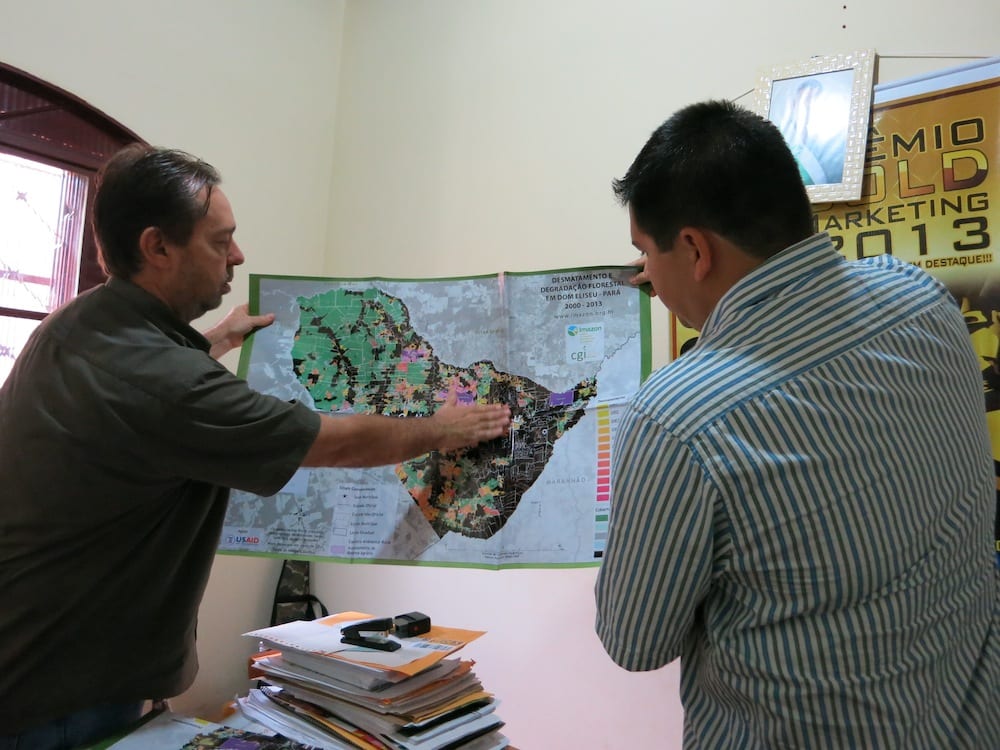


To Edilberto Poggi, the issue isn’t whether to stop the illegal deforestation of the Amazon and better manage the land resources—the need to do that is clear to him. The real question is how this can be done using the laws already on the books and the resources that are available to him and his colleagues.
Sitting in his office in Dom Eliseu, a municipality in the state of Pará in the Brazilian Amazon, the environmental manager of this small but vibrant town knew that the key was identifying where lumber was being harvested illegally while allowing legal landowners to manage their land within the law.
Poggi had hired a strong team to actively pursue land registration and licensing as required by law. By last August, he had more than 300 requests for environmental licenses for legal use of the land waiting for his team’s attention. Pointing to a mountain of papers, he noted that a large stack of verified information was required for each property, a paperwork nightmare making it impossible to move forward quickly. Poggi and municipal managers like him throughout the state needed a better way to make the system work to effectively manage the land, rather than leaving it open to indiscriminate logging.
Fortunately for Poggi and his colleagues, a new, computer-based environmental management system will greatly speed up the process. Known by the acronym SIGAM, it was launched last week by the Brazilian nonprofit organization Imazon. At the click of a mouse, managers can pull up all the information they need on a certain parcel of land – the boundaries, the land registration, a map which verifies the landcover, and even evidence that a municipal worker has visited and “ground-truthed” all of the information.
With SIGAM, any mismatches are immediately apparent. Two owners claim the same strip of land? The dispute will be immediately apparent. Deforestation along a river bank? That too is clearly noted. The system is transparent, integrated, auditable and meets guidelines and laws. There is a desktop version and even a mobile application, which can be used during field visits to verify the information.
SIGAM’s impact is much deeper than simply relieving the paperwork burden for overworked bureaucrats, however. The system, which was two years in the making, will give a true picture of the actual condition of the land cover and provide an accurate way of monitoring it, with up-to-date information at users’ fingertips. And for municipal leaders less eager to resolve sticky forestry issues, there is no longer an excuse for not having the information needed to make decisions.
“In 2012, when the responsibility for environmental management was shifted to the municipal level, such a tool became a requirement. Existing systems were expensive and difficult to adapt so we decided to develop a low-cost tool on open source software,” saidAmintas Brandão Jr., SIGAM project manager.
“The results are beyond our expectations,” stated Carlos Souza Jr., a senior researcher at Imazon. When the system was rolled out in Paragominas this week, the response was very enthusiastic. The only complaint was potential users couldn’t get access to it fast enough.
The development of SIGAM was funded by USAID under the Innovation Investment Alliance, a partnership between USAID and the Skoll Foundation supported by Mercy Corps, which focuses on identifying proven innovations and scaling them up to expand their impact. In Pará, Imazon is scaling work that was started in the municipality of Paragominas. By providing accurate maps and data and strengthening local use of the information, Imazon’s work contributed to a reduction in the rate of deforestation while supporting economic growth based on a foundation of legal land use.
By the end of 2015, Imazon expects to have rolled out SIGAM to 50 of the 144 municipalities in Pará, the state environmental agency and others involved in environmental issues, including nonprofit organizations. At the state level, SIGAM provides accurate, up-to-date information to monitor environmental management throughout the state. Several other states, including the neighboring state of Matto Grosso, are studying SIGAM as they build similar systems.
Addressing issues of deforestation and management of natural resources in the Amazon is complex and multifaceted. Tools such as SIGAM support concrete actions that lead to real changes on the ground. And with less paper to push and a clear picture of what is happening in his municipality, Poggi and others like him can do the important work of protecting the environment while supporting legal uses of forest resources. This will ensure that his town can thrive while forest cover in the Amazon is sustained.
Photo: Carol Skowron/Mercy Corps.
Source: Global Envision
This post was published on 6 de April de 2015
States with the most deforestation in January were Mato Grosso, Roraima and Pará Deforestation…
According to the Green Radar report, in 2024, out of the 146 companies assessed, 6…
A survey of more than 3,500 lawsuits showed an increase in punishments, while payment of…
A group made up of specialists from 23 different professions trained in the Sustainable Amazon…
The degraded area increased due to burning, especially in August and September In 2024,…
The program is scheduled to last 15 years and will include local indigenous peoples and…